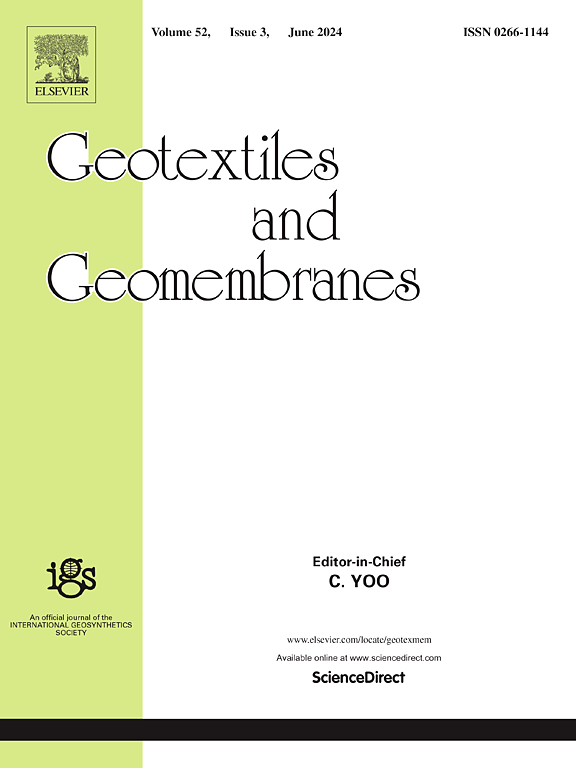Seismic response and mitigation measures for T shape retaining wall in liquefiable site
IF 6.2
1区 工程技术
Q1 ENGINEERING, GEOLOGICAL
引用次数: 0
Abstract
Focusing on a T-shape cantilever retaining wall in a liquefiable site, a series of shaking table model tests were conducted to investigate the seismic stability characteristics of the wall when using EPS composite soil isolation piles (WEP), EPS composite soil isolation walls (WEW), and backfilled natural fine sand from Nanjing (WSS). The seismic response characteristics of the model ground soil and the retaining wall for the three models were comparatively analyzed regarding the acceleration, displacement, dynamic earth pressure and excess pore water pressure ratio. Moreover, the seismic performance of anti-liquefaction measures in the liquefiable ground with EPS composite isolation structures were discussed from the view of the phase characteristics and energy consumption. The results indicate that under the same peak ground acceleration, the excess pore water pressure in the WEP and WEW models is significantly lower than that in the WSS model. Different from WSS, WEP and WEW exhibit a segmented distribution with the buried depth in acceleration amplification factors. The embedding of isolation structures in liquefiable sites can reduce the wall sliding and rotational displacements by approximately 25%–50%. In addition, the out-of-phase characteristics of dynamic earth pressure increment are evidently different among WEP, WEW and WSS. There is an approximate 180° phase difference between the dynamic earth pressure behind the wall and the inertial force in the WEP and WEW models. EPS composite soil isolation structures show good energy dissipation characteristics, and especially the isolation wall is better than isolation pile. The displacement index of WSS retaining wall is significantly larger than that of WEW and WEP, indicating that EPS composite isolation piles and wall play an important role in the mitigating damage to the retaining wall. This study can provide references for the application of isolation structures in the liquefiable ground soil regarding the seismic stability.
可液化场地 T 型挡土墙的地震响应和缓解措施
针对液化场地中的 T 型悬臂挡土墙,进行了一系列振动台模型试验,研究了采用 EPS 复合土隔离桩(WEP)、EPS 复合土隔离墙(WEW)和回填南京天然细砂(WSS)时挡土墙的地震稳定性特征。比较分析了三种模型的加速度、位移、动土压力和孔隙水超压比等模型地基土和挡土墙的地震响应特性。此外,还从相位特征和能耗的角度讨论了采用 EPS 复合隔震结构的液化地层抗液化措施的抗震性能。结果表明,在相同的地表加速度峰值下,WEP 和 WEW 模型的过剩孔隙水压力明显低于 WSS 模型。与 WSS 模型不同的是,WEP 和 WEW 模型的加速度放大系数随埋设深度呈分段分布。在可液化场地嵌入隔离结构可将墙体滑动和旋转位移减少约 25%-50%。此外,WEP、WEW 和 WSS 的动土压力增量的非相位特性明显不同。在 WEP 和 WEW 模型中,墙后动土压力与惯性力之间存在大约 180° 的相位差。EPS 复合土体隔震结构表现出良好的消能特性,尤其是隔震墙的消能特性优于隔震桩。WSS 挡土墙的位移指数明显大于 WEW 和 WEP 挡土墙的位移指数,说明 EPS 复合隔震桩和隔震墙在减轻挡土墙破坏方面发挥了重要作用。本研究可为可液化地基土中隔震结构的抗震稳定性应用提供参考。
本文章由计算机程序翻译,如有差异,请以英文原文为准。
求助全文
约1分钟内获得全文
求助全文
来源期刊

Geotextiles and Geomembranes
地学-地球科学综合
CiteScore
9.50
自引率
21.20%
发文量
111
审稿时长
59 days
期刊介绍:
The range of products and their applications has expanded rapidly over the last decade with geotextiles and geomembranes being specified world wide. This rapid growth is paralleled by a virtual explosion of technology. Current reference books and even manufacturers' sponsored publications tend to date very quickly and the need for a vehicle to bring together and discuss the growing body of technology now available has become evident.
Geotextiles and Geomembranes fills this need and provides a forum for the dissemination of information amongst research workers, designers, users and manufacturers. By providing a growing fund of information the journal increases general awareness, prompts further research and assists in the establishment of international codes and regulations.
 求助内容:
求助内容: 应助结果提醒方式:
应助结果提醒方式:


